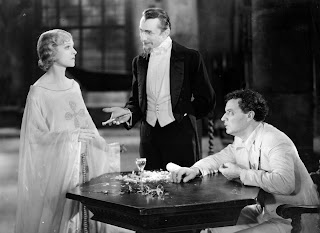Victor Halperin, 1932
Starring: Bela Lugosi, Madge Bellamy, Joseph Cawthorn, John Harron
“I thought beauty alone would satisfy me – but the soul is gone.”
A young woman, Madeleine Short, arrives in Haiti to marry her fiancé, Neil Parker. They meet plantation owner Charles Beaumont, who quickly falls in love with Madeleine, and Murder Legendre, a mysterious voodoo master. Legendre employs a number of zombified slaves to operate a sugar mill and unnerves Madeleine. In his desperation to have Madeleine for himself, Beaumont asks Legendre for help and he gives him a drug to secretly administer to Madeleine. It doesn’t take effect until after she and Parker are married. She appears to have died and, wracked with grief, Parker is forced to bury her. He soon has visions of her and comes to find that her tomb is empty, because Legendre has revived her.
Beaumont, meanwhile, is unhappy with Madeleine’s blank, unresponsive state and asks Legendre to change her back. Predictably, he refuses and turns Beaumont into a zombie. A missionary helps Parker confront Legendre at his foreboding mansion on a cliff. Legendre tries to make the zombies kill Parker and the missionary, but he is knocked out and they march over the edge of the cliff when the telepathic link is broken. Beaumont and Legendre fight and also fall of the cliff, and upon Legendre’s death, Madeleine returns to her normal state with Parker at her side.
While White Zombie is a pre-Code film, it is less subversive than other horror films from the period, such as Freaks, Dr. Jekyll and Mr. Hyde, and Island of Lost Souls. Though Madeline’s zombie-state has terrifying implications, it doesn’t go nearly as far as it could have and sort of glosses over the fact that, in this state, she is essentially little more than a sex slave. As with most early American horror, the primary romantic relationship is tedious and boring, though Parker’s desperation later in the film at least allows this rise above the bland relationships in Dracula and The Mummy. His despair and isolation is absolute in one particular scene where he sits drinking at a bar, alone, only surrounded by the shadows other people who don’t appear on screen.
The blatant racism will likely bother a lot of modern viewers and it is frustrating that the film expects us to see the primary horror is Madeleine zombified state, simply because she is a white woman. Though Haiti is the setting, it completely ignores the Haitians and goes so far as to replace black extras with white people in black face. Repulsive stuff. Though the zombie make up is from the wonderful Jack Pierce (Frankenstein, among many other films), the mass of working zombies really only exist in the background of the film.
This is the first zombie film, but is not about the flesh eating undead, rather it is inspired by Haitian voodoo. Unlike other horror films from the period, this doesn’t have a direct literary source, but was inspired by The Magic Island (1929), a non-fiction book from William Seabrooks about Haitian voodoo. Murder Legendre goes about the process of zombification with a drug, a ritual, and exerts his control via telepathy. There is a sadism inherent in his actions and personality, something the film fails to explore to the fullest degree, only truly showing it in the scene where Beaumont is slowly and painfully turned into a zombie.
Bela Lugosi puts in a great performance as Murder Legendre (what a name) and is almost able to carry the film on his own. Robert Frazer is largely unlikable as Beaumont, though that fits with his role. Lead Madge Bellamy is lovely, but she is unfortunately far more compelling as a zombie than a living woman. John Harron, who plays Madeleine’s fiancé Parker, is in the mold of most Universal romantic leads and is mostly forgettable.
This is definitely a flawed film and doesn’t quite rise to the heights of the best horror movies of the period. The acting is pretty awful, which is no surprise considering it’s made up mostly of silent actors who had trouble getting work in the burgeoning field of sound cinema. The lack of nearly constant dialogue, as in Dracula, does give the film a more fantastical, nightmarish feel, and as with Island of Dr. Moreau, there are some wonderful sound effects and moments of silence. The excellent opening scene, a nighttime funeral where the Haitians chant hauntingly, is an example of some of the best this film has to offer. Though the acting and plot may fail, to a degree, cinematographer Arthur Martinelli nearly makes up for this with many impressive visuals. Though this was a low budget film, it looks excellent because of the use of many of Universal’s sets and the work of designer Ralph Berger. Allegedly pieces of the sets from Dracula, Frankenstein, The Cat and the Canary, and the oft-recycled Hunchback of Notre Dame were used.
White Zombie was financially successful on its release, but received negative reviews, though it is now regarded as a lesser cult classic. Its far inferior sequel, Revolt of the Zombies (1936), is largely ignored and forgotten. Though this isn’t as haunting or meditative as Val Lewton’s later I Walked With a Zombie, it is certainly a minor horror classic and comes recommended because of the excellent atmosphere and camera work. White Zombie is available on DVD and on Blu-ray from Kino, and though I hear the restoration work on the latter is not particularly impressive, Kino’s version comes recommended.


No comments:
Post a Comment